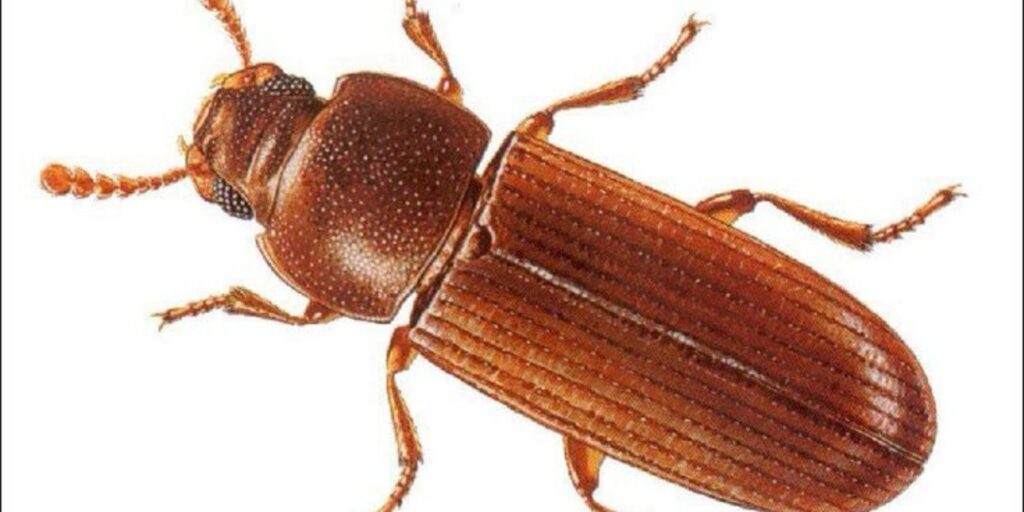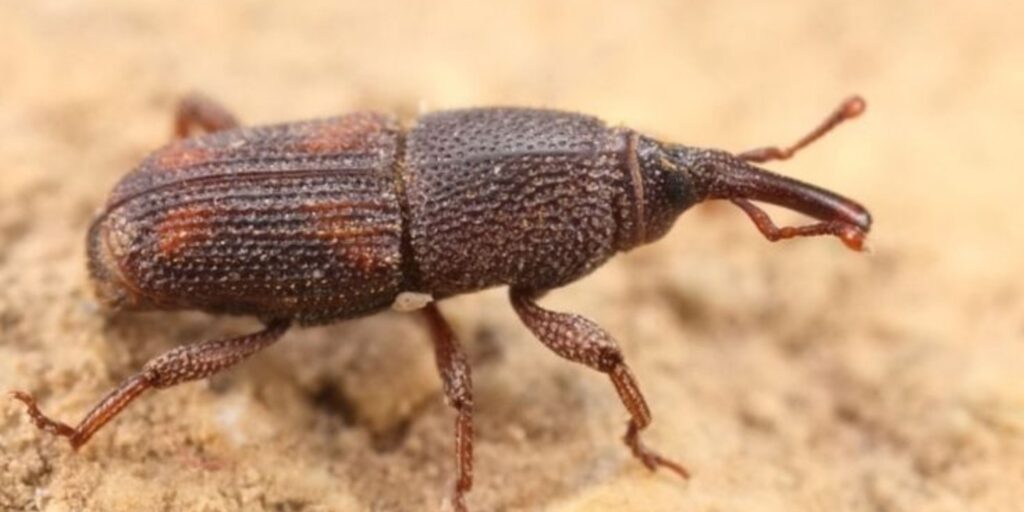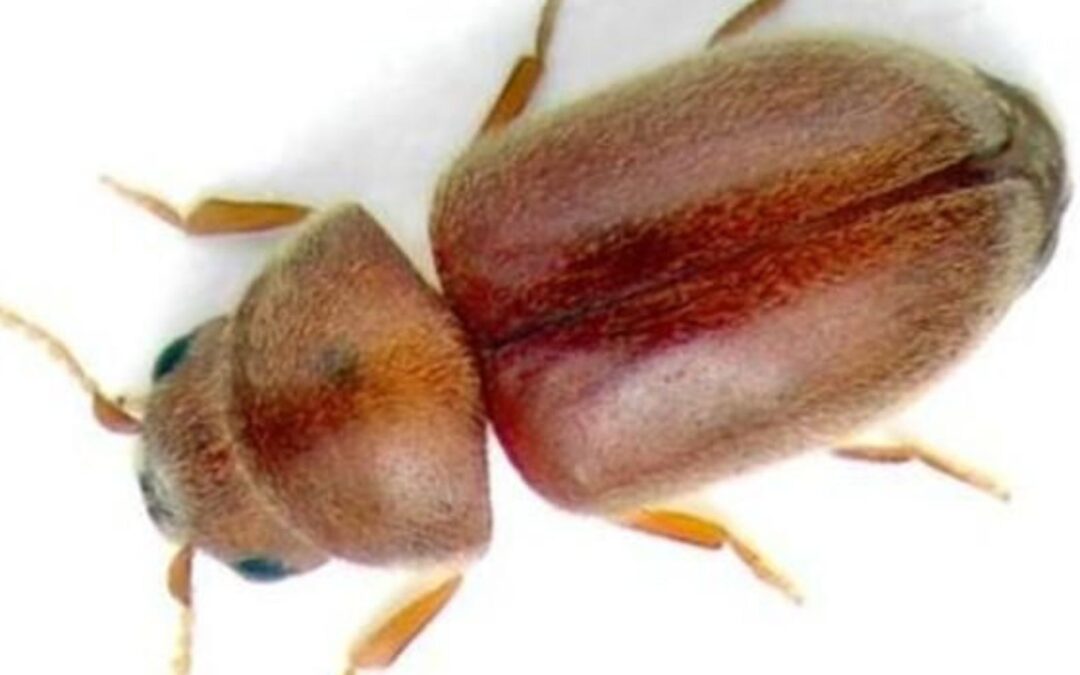The life cycle of a cigarette beetle follows a typical beetle development process, comprising four distinct stages: egg, larva, pupa, and adult. The cycle begins when the female cigarette beetle lays tiny, white eggs on or near food sources like tobacco, spices, dried herbs, or stored food products. These eggs hatch within a few days, releasing larvae, which are the destructive stage of the beetle. The larvae, which resemble small, pale worms, burrow into their food sources, feeding on them for several weeks. During this time, they cause significant damage to stored products, often leaving behind powdery residue and small holes in the packaging. After feeding and growing, the larvae pupate, forming a protective cocoon around themselves.
This pupal stage lasts anywhere from a few days to a few weeks, depending on environmental conditions. Once the beetles mature inside their cocoons, they emerge as adult cigarette beetles, which are small, reddish-brown insects with a distinctive cylindrical shape. The adult beetles are ready to reproduce, and the cycle begins again. The entire life cycle can take anywhere from 2 to 4 months, depending on the temperature and availability of food. Understanding this cycle is crucial for controlling infestations, as each stage presents a different opportunity for intervention.
What Is a Cigarette Beetle?

Before jumping into its life cycle, it’s essential to understand what a cigarette beetle is. Scientifically known as Lasioderma serricorne, this insect is a common pest found in food storage facilities, homes, and processing plants. It earned its name from its infamous tendency to infest tobacco products like cigarettes, cigars, and chewing tobacco. However, the beetle isn’t just limited to tobacco—it targets a wide variety of stored products such as dried fruits, spices, grains, and even books and furniture when hungry enough.
What is the life cycle of a cigarette beetle? : Key Characteristics of a Cigarette Beetle
- Size: Small, about 2-3 millimeters in length.
- Color: Light brown to reddish-brown.
- Shape: Oval-shaped body with a pronounced head tucked downward, giving it a “hunched” appearance.
- Behavior: Active flyers, especially in warm conditions.
By understanding its physical traits, you’ll be better equipped to identify cigarette beetles and their life stages.
What is the life cycle of a cigarette beetle? v: The Life Cycle of a Cigarette Beetle
Like many other beetles, the cigarette beetle undergoes a complete metamorphosis, which consists of four distinct stages. Each stage has its unique characteristics and role in the insect’s development.
What is the life cycle of a cigarette beetle? : Egg Stage
The life cycle begins with eggs, which the adult female beetle lays. Depending on environmental conditions, a female cigarette beetle can lay 30-100 eggs during her lifetime.
- Where are eggs laid? Eggs are often deposited directly on or near food sources, such as tobacco leaves, stored grains, or dried goods.
- Egg size: The eggs are tiny and almost invisible to the human eye, measuring only about 0.5 millimeters.
- Incubation period: The eggs typically hatch within 6-10 days at room temperature.
What is the life cycle of a cigarette beetle? : Larval Stage
Once the eggs hatch, the larvae emerge—where most damage occurs. The larvae are creamy-white with a slightly curled body and are voracious feeders.
- Feeding behavior: The larvae burrow into food sources, consuming large amounts of material to fuel their growth. Products like tobacco, cereal grains, spices, and packaging material are at risk.
- Time spent as larvae: Depending on temperature and food availability, the larval stage can last anywhere from 5 to 10 weeks.
- Vulnerability: This stage is the most susceptible to environmental conditions. Larvae require warmth and food to thrive.
Fun fact: Larvae don’t need much water to survive because they extract moisture from their food source!
What is the life cycle of a cigarette beetle? : Pupal Stage
Once the larvae have gained enough nutrients, they enter the pupal stage. During this period, the larvae form cocoons made from nearby food particles, creating a protective case while transforming into adults.
- Duration: The pupal stage generally lasts between 1 and 3 weeks, depending on environmental factors like humidity and temperature.
- Appearance: Pupae are motionless and confined within their cocoon. At first, they appear creamy white and darken as the adult beetle forms.
The pupal stage is critical because it prepares the beetle for the final phase of its life cycle—adulthood.
- Adult Stage
After emerging from the pupa, the beetle reaches its adult stage. Adult cigarette beetles are responsible for mating and perpetuating the cycle.
- Lifespan: Adult cigarette beetles live for approximately 2 to 6 weeks.
- Activity: They are strong fliers and are most active during the evenings.
- Role: Adult beetles do not feed much, as their primary goal is reproduction. They seek suitable locations to lay eggs, ensuring the next generation’s survival.
Once the lifecycle is complete, the process begins again, enabling rapid infestations if left unchecked.
Environmental Factors Influencing the Cigarette Beetle Life Cycle
Cigarette beetles are highly sensitive to environmental conditions. Here’s what influences their growth and reproduction:
- Temperature:
- Optimal growth occurs between 77°F and 86°F (25°C to 30°C).
- Temperatures below 65°F (18°C) significantly slow down their development.
- Humidity:
- High humidity accelerates the life cycle by creating ideal larval feeding and pupation conditions.
- Food Availability:
- With abundant food sources, the population can explode within months.
- Light:
- These beetles are phototactic, meaning they are attracted to light. This behavior makes them easier to spot in infested areas.
Understanding these factors allows businesses and homeowners to implement preventative strategies effectively.
Preventing Cigarette Beetle Infestations
Controlling cigarette beetles begins with an understanding of their life cycle. Here are a few proven strategies to prevent infestations:
- Proper Storage Practices
- Use airtight containers to store susceptible goods like grains, spices, and tobacco products.
- Ensure storage areas are kept cool and dry to discourage beetle development.
- Regular Inspections
- Check packages, pantry shelves, and storage areas for signs of beetles, larvae, or cocoons.
- Pay special attention to cracks and crevices where beetles may lay eggs.
- Dispose of Infested Products
- Immediately discard any items showing signs of an infestation.
- Clean the storage area thoroughly to eliminate any remaining eggs or larvae.
- Use Traps and Pesticides
- Light traps and pheromone traps can help monitor and reduce beetle populations.
- If necessary, consult a pest control professional to apply targeted treatments.
Being proactive in handling cigarette beetles can help you maintain a pest-free environment.
Why Understanding Their Life Cycle Matters
The life cycle of the cigarette beetle is a critical aspect of effective pest management. From the moment the eggs are laid to the emergence of adult beetles, understanding the specific stages of development can guide you in taking preventive measures. Each phase presents unique opportunities for control, whether it’s identifying potential breeding sites or taking steps to disrupt their growth. By recognizing the vulnerabilities of each stage, you can protect your home, business, or products from costly damage.
The Cigarette Beetle’s Life Cycle: A Roadmap to Prevention
Understanding the cigarette beetle’s life cycle allows for targeted pest control strategies. Cigarette beetles typically undergo four stages: egg, larva, pupa, and adult. The eggs hatch into larvae, which feed on a variety of materials, including tobacco, spices, and stored food. Once they’ve matured, they pupate before emerging as fully formed adults ready to reproduce. During each stage, specific actions can be taken to reduce the chances of infestation, whether it’s improving storage conditions or keeping an eye out for the telltale signs of beetle activity.
How to Monitor for Beetle Activity
Knowing how to spot the signs of a cigarette beetle infestation is vital for early detection. These beetles are often most active in storage areas where food, tobacco, or other organic materials are present. Common indicators include small, round holes in packages, powdery residue from the beetle’s larvae, and visible beetles or larvae themselves. Early intervention can prevent the spread of the infestation, saving you from larger-scale damage later on.
Proper Storage Practices: A Key Preventive Measure
Proper storage practices are essential to preventing cigarette beetle infestations. Since these beetles are attracted to organic materials like dried plants, food, and tobacco, keeping these items stored in airtight containers is crucial. Regularly inspecting your pantry or storage areas and keeping a clean environment will further reduce the likelihood of an infestation. By controlling the environment, you can make your space less appealing to cigarette beetles.
Seeking Professional Assistance for Infestation Control

If you’ve already noticed signs of a cigarette beetle infestation, it’s important to act quickly. A professional pest control service can conduct a comprehensive inspection to identify the full extent of the infestation. From there, they can implement an effective treatment plan, addressing the specific life stages of the beetles to eliminate the problem at its source. Pest control experts have the knowledge and tools to tackle infestations safely and effectively, ensuring peace of mind and long-term protection.

